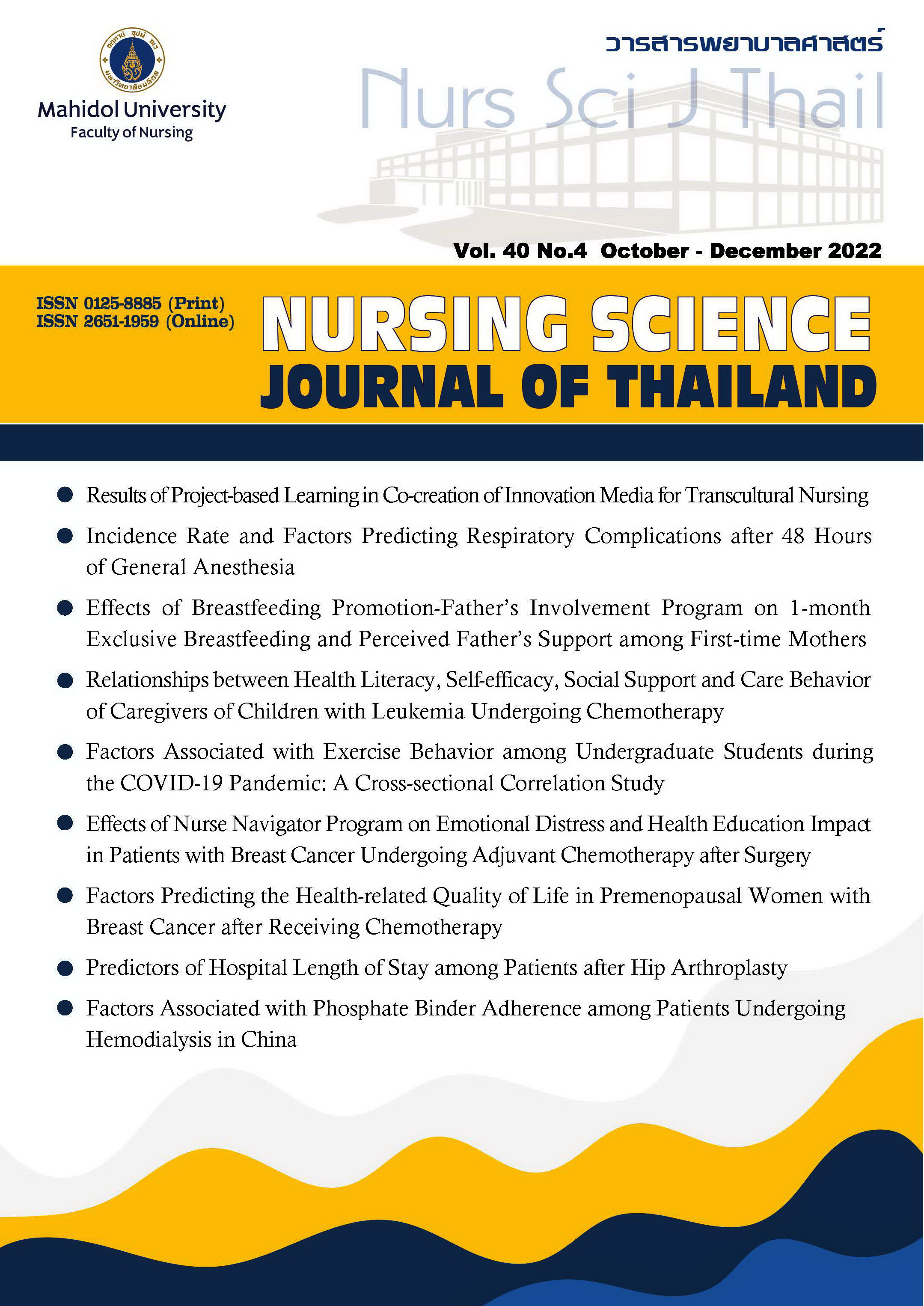Relationships between Health Literacy, Self Efficacy, Social Support and Care Behavior of Caregivers of Children with Leukemia Undergoing Chemotherapy
Main Article Content
Abstract
Purpose: To examine relationships between health literacy, self-efficacy, social support and care behavior of caregivers of children with leukemia receiving chemotherapy.
Design: Correlational descriptive design.
Methods: The study sample included 85 caregivers of children with leukemia receiving chemotherapy aged 1-5 years attending at the pediatric hematology, oncology clinics and pediatric wards in four tertiary hospitals in Bangkok, The subjects were selected by convenience sampling, Questionnaires were used in collecting data including 1) demographic data questionnaire 2) care behavior questionnaire 3) health literacy questionnaire 4) social support questionnaire, and 5) self-efficacy questionnaire. Data analysis used were descriptive statistics and Spearman’s rank-order correlation.
Main findings: Care behavior of caregivers of children with leukemia receiving chemotherapy was at high level. Health literacy and self-efficacy were significantly and positively correlated with care behavior of caregivers (r = .45, p < .01, r = .31, p < .01), respectively. However, social support was not correlated with care behavior of these caregivers (r = .13, p > .05).
Conclusion and recommendations: According to the study findings, care behavior of caregivers was at a high level, and care behavior was correlated with heath literacy and self-efficacy. Therefore, healthcare team, especially physicians and nurses should enhance health literacy and self-efficacy of these caregivers. These strategies would improve care behavior of caregivers of children with leukemia receiving chemotherapy at home.
Article Details

This work is licensed under a Creative Commons Attribution-NonCommercial-NoDerivatives 4.0 International License.
Copyright Notice: Nursing Science Journal of Thailand has exclusive rights to publish and distribute the manuscript and all contents therein. Without the journal’s permission, the dissemination of the manuscript in another journal or online, and the reproduction of the manuscript for non-educational purpose are prohibited.

Disclaimer: The opinion expressed and figures provided in this journal, NSJT, are the sole responsibility of the authors. The editorial board bears no responsibility in this regard.
References
Heron M. Deaths: Leading causes for 2013. Natl Vital Stat Rep. 2016;65(2):1-95.
Imsamran W, Chaiwerawattana A, Wiangnon S, Pongnikorn D, Suwanrungrung K, Sangrajrang S, et al. Cancer in Thailand Vol. VIII, 2010-2012. Bangkok: New Thammada Press (Thailand); 2017. 178 p. (in Thai).
Medication Records and Statistic Units, Chulalongkorn Hospital. Statistic of children with cancer in department of pediatric. Bangkok: Medication Record and Statistic Units, Chulalongkorn Hospital; 2016. 10 p. (in Thai).
Capo G, Waltzman R, Managing hematologic toxicities. J Support Oncol. 2004;2(1):65-79.
The Thai Society of Hematology. National protocol for the treatment of childhood cancers. Bangkok: M Print Collaboration; 2016. 56 p. (in Thai).
de Naurois J, Novitzky-Basso I, Gill MJ, Marti FM, Cullen MH, Roila F, et al. Management of febrileneutropenia: ESMO clinical practice guidelines. Ann Oncol. 2010;21 Suppl 5:v252-6. doi: 10.1093/annonc/mdq196.
Klunklin P, Thaiyapirom N, Woragidpoonpol P. Health promotion for children of all ages. Khon Kean: Printing Press; 2012. 292 p. (in Thai).
Lengnoi N. Factors influencing mothers' behaviors in promoting the health of children with cancer. Songklanagarind Journal of Nursing. 2005;12(1):11-22. (in Thai).
Sanpakit K, Phuakpet K, Vathana N. Self-care guide for pediatric patients receiving chemotherapy, Vol.3 [handbook]. Bangkok: Roche Thailand; 2017. 10 p. (in Thai).
Orem DE. Nursing concept of practice. 6th ed. St. Louis: Mosby; 2001. 542 p.
Songkongdang W, Kantawang S, Niyomkar S. Factors influencing caregivers’ behaviors regarding nutritional care for preventing infection in leukemic children with chemotherapy induced neutropenia. Nursing Journal. 2015;42 Special 2:94-106. (in Thai).
Mahasaro P, Suwannaroop N, Watthayu N. Factors predicting caring behaviors among caregivers of 1-6 years old asthmatic children. Nursing Science Journal of Thailand. 2017;35(2):64-73. (in Thai).
Tapin P, Boonchieng W, Suttajit S. Parental health literacy and behavior to prevent hand-foot-and-mouth disease in child development Center of Charoen Mueang Sub-district, Chiang Rai. Lampang Medical Journal 2018;39(2):72-80. (in Thai).
Santawaja C. Basic concept, theory and nursing process. Bangkok: Transplace; 2005. 122 p. (in Thai).
Sorensen K, Van den Broucke S, Fullman J, Doyle G, Pelikan J, Slonska Z, et al. Health literacy and public health: a systemic review and integration of definitions and models. BMC Public Health. 2012;12:80. doi: 10.1186/1471-2458-12-80.
Bandura A. Self-efficacy: the exercise of control. New York: W.H. Freeman and Company; 1997. 118 p.
Cohen J. Statistical power analysis for the behavioral sciences. 2nd ed. Hillsdale, NJ: Lawrence Erlbaum Associates; 1988. 567 p.
Jansong W, Chaiyawat W. The effect of the nursing intervention based on Pender’s health promotion model on infection prevention behaviors in mothers of 1-5 year children with cancer undergoing chemotherapy. Thai Red Cross Nursing Journal. 2016;9(2):159-72. (in Thai).
Chanpa M, Sanasuttipaun W. Srichantaranit A. Relationship among children’s age, caregiver’ perceived severity of illness, stress, social support and quality of life among caregivers of children with congenital heart disease. Nursing Journal. 2018;36(1):73-86. (in Thai).
Thato R. Nursing research: concepts to application. Bangkok: Chulalongkorn University; 2018. 590 p. (in Thai).
Brega AG, Thomas JF, Henderson WG, Batliner TS, Quissell DO, Braun PA, et al. Association of parental health literacy with oral health of Navajo Nation preschoolers. Health Educ Res. 2017;31(1):70-81. doi: 10.1093/her/cyv055.


